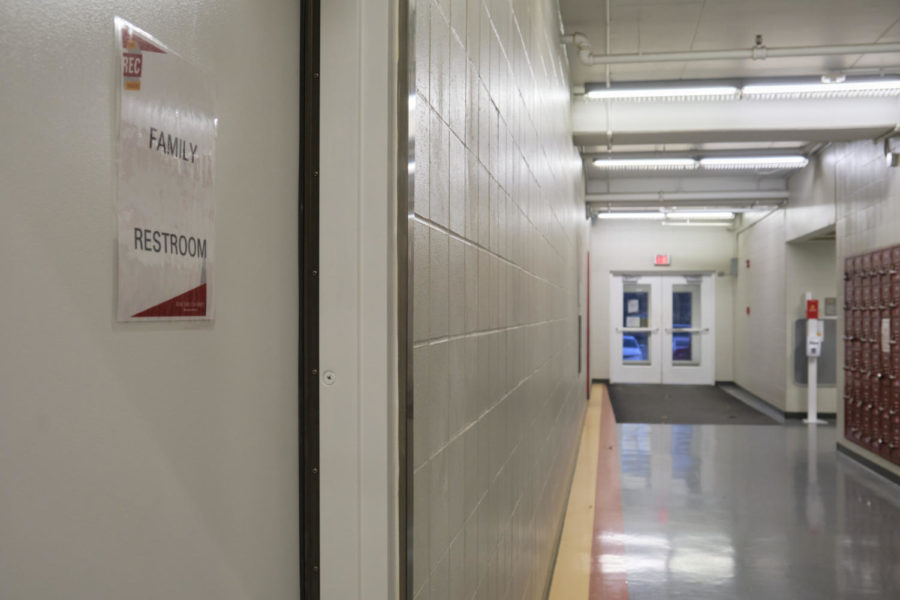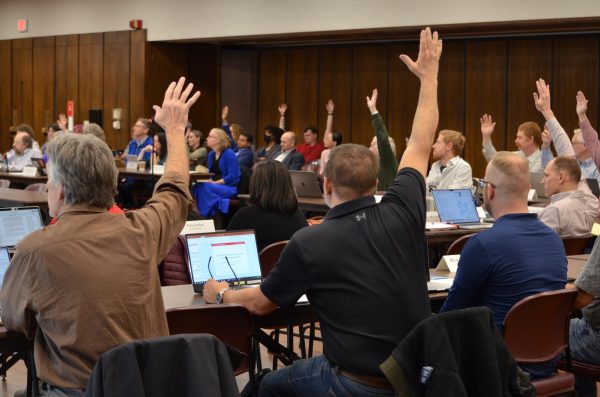- News
- News / Politics And Administration
- News / Politics And Administration / Campus
- News / Student Life
- Politics
Lied Rec opens first all-gender restroom
A new gender neutral bathroom has been added to Lied Rec. Dec. 4, 2022.
Lied Recreation Athletic Center was built in 1990 and has 20 basketball courts, two indoor tracks, a boxing studio, a bouldering wall and now, an all-gender restroom.
Since Wednesday, visitors to Lied have had access to a restroom that is accommodating to students and guests of all genders. Additionally, the building is more family and disability friendly because of the single, spacious restroom option.
The project started out as a diversity issue for Kit Clayburn, senior in animal ecology and facilitator of the project. Two years ago Clayburn was tasked with finding spaces that had all-gender restrooms on campus when he realized that Lied had none.
Clayburn decided to work on the project to help students who do not use gender-specific restrooms but saw a bigger opportunity the more he researched the project.
“The main tipping point was to accommodate for students who don’t use gender-specific bathrooms, but as I got into this more, it became a bigger issue,” Clayburn said, “with people who are wheelchair bound, families who have someone who is wheelchair bound that needs to help them go to the bathroom or if there are any parents or families who have children who need to have a private bathroom.”
The new accommodation provides an important feature to campus, and Clayburn hopes that visitors will feel welcome when they see the restroom.
“If there is anyone outside of Iowa State who is in the community who sees this bathroom, [the restroom] just shows that Iowa State is an environment for inclusivity and is an environment for everyone to come to, no matter your identity, and have the college experience that everyone promises,” Clayburn said.
Susan Harper, director of the Center for LGBTQIA+ Student Success, agrees with Clayburn.
“Having all-gender restrooms on campus also serves as a visible message that students of all genders are seen on campus, that their needs are considered and that their safety and comfort matter,” Harper stated in an email response to the Daily.
As Clayburn worked more on the project, he realized that the project was bigger than just creating a more inclusive space for transgender, nonbinary and gender expansive students, but also for students and visitors with disabilities or children.
“We are representing a wide variety of students and guests at Iowa State, and just having that bathroom accommodates everyone,” Clayburn said.
Clayburn worked with a number of campus partners, including Recreation Services, the Office of the Vice President of Student Affairs and Student Government.
Douglas Arrowsmith, building supervisor for Lied Recreation Athletic Center, is happy with the project and believes that the project was long overdue.
“I believe it will provide for a better experience for all of our patrons,” Arrowsmith stated in an email response to the Daily. “It will help ease the wait times for larger events like track meets and will also provide space for an under-served population.”
The building was not built with an all-gender restroom for multiple reasons, according to Arrowsmith.
“In 1990 when the facility opened and ADA [Americans with Disabilities Act] passed, gender neutral type spaces and codes were much different than today, and it wasn’t something that was really considered or required,” Arrowsmith stated. “I don’t think they envisioned hosting larger scale events like we do today. I know they were trying to keep costs down, so one area they really underestimated was the importance of multiple restroom spaces.”
The Center for LGBTQIA+ Student Success estimates there are around 50 all-gender restrooms on the main Iowa State campus.
Harper defines an all-gender restroom as “any single-stall, lockable restroom that is open to the public and has signage that indicates that people of any gender may use it.” Harper stated that all-gender restrooms provide a space for people to be private during vulnerable times.
“These restrooms provide a private space to take care of intimate bodily needs – from the obvious reasons people use a bathroom, to accessing menstrual supplies and attending to those needs, to administering injectable medications such as testosterone in a space with a sharps container,” Harper stated.
Some all-gender restrooms on campus were once single-gender restrooms, and some are new, created during building remodels or the creation of new buildings.
All-gender restrooms benefit all people and ultimately provide more opportunities for people to use a restroom.
“On a practical note, having access to all-gender restrooms can help to alleviate long waits at public events such as conferences, since anyone of any gender can use an all-gender bathroom, rather than having to wait for one assigned to a specific gender,” Harper stated.
According to Harper, many of the all-gender restrooms on campus can be found on the MyState app. Harper asks students to fill out this form whenever they come across an all-gender restroom not listed on the MyState app.
Your donation will support the student journalists of the Iowa State Daily. Your contribution will allow us to purchase equipment, send our student journalists to conferences and off-set their cost of living so they can continue to do best-in-the-nation work at the Iowa State Daily.













